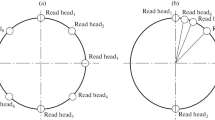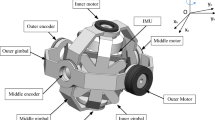Abstract
Oil contamination has a detrimental influence on the spaceborne quasi-absolute optical encoder because it introduces errors in angular displacement measurement. To reduce these errors and prevent the failure of the spaceborne quasi-absolute optical encoder caused by oil contamination, this paper proposes a multi-reference identification algorithm for the absolute angular displacement and a multi-reading-head data fusion algorithm. First, the composition of the spaceborne quasi-absolute optical encoder and the design of the processing circuit are introduced. Second, a multi-reference identification algorithm of the absolute angular displacement is proposed to prevent the misidentification of absolute angular displacement due to oil contamination. Moreover, a multi-reading-head data fusion method was employed to determine and eliminate the erroneous reading head measurement data. The effectiveness of this method was verified by experimentally comparing the angular displacement curves and angular velocity curves obtained from a quasi-absolute angular displacement measuring device, with and without the application of the proposed method. The effects of oil contamination on the accuracy of measurement were also compared. The results indicated that after application of the method, the error in the angular displacement measured by the code disk due to oil contamination was significantly reduced, ensuring the correctness and reliability of the angle-displacement measurement, although the accuracy of measurement was still slightly influenced. Thus, the proposed method is considered to have practical value for making the spaceborne quasi-absolute optical encoder better against the influence of oil contamination.











Similar content being viewed by others
Data availability
The authors will supply the relevant data in response to reasonable requests.
References
Kaushal, H., Kaddoum, G.: Optical communication in space: challenges and mitigation techniques. IEEE Commun. Surv. Tuts. 19(1), 57–96 (2017)
Wang, Q., Liu, Y., Ma, J., Tan, L., Yu, S., Li, C.: Quick acquisition and recognition method for the beacon in deep space optical communication. Appl. Opt. 55(34), 9738–9743 (2016)
Yu, H., Wan, Q., Sun, Y., Lu, X., Zhao, C.: High precision angular measurement via dual image detectors. IEEE Sensors J. 19(17), 7308–7312 (2019)
Yu, H., Jia, X., Wan, Q., Liang, L., Zhao, C.: High-resolution angular displacement technology based on vary moiré fringe phase positons. IEEE Sens. J. 19(6), 2126–2132 (2019)
Chen, Z., Liu, X., Peng, K., Yu, Z., Pu, H.: A self-adaptive interpolation method for sinusoidal sensors. IEEE Trans. Instrum. Meas.Instrum. Meas. 69(10), 7675–7692 (2020)
Chen, Z., Segev, M.: Highlighting photonics: looking into the next decade. eLight 1, Art. No. 2 (2021)
Quan, L., Shimuzu, Y., Xiong, X., Matsukuma, H., Gao, W.: A new method for evaluation of the pitch deviation of a linear scale grating by an optical angle sensor. Precis. Eng. 67, 1–13 (2021)
Odinokov, S., Shishova, M., Kovalev, M., Zherdev, A., Lushnikov, D.: Phase imbalance optimization in interference linear displacement sensor with surface gratings. Sensors 20(5), 1453 (2020)
Ye, G., et al.: Optimal design of a reflective diffraction grating scale with sine-trapezoidal groove for interferential optical encoders. Opt. Lasers Eng. 134, Art. No. 106196 (2020)
Li, X., et al.: Two-probe optical encoder for absolute positioning of precision stages by using an improved scale grating. Opt. Exp. 24(19), 21378–21391 (2016)
Iafolla, L., Filipozzi, M., Freund, S., Zam, A., Rauter, G., Cattin, P.C.: Machine learning-based method for linearization and error compensation of a novel absolute rotary encoder. Measurement 169, Art. No. 108547 (2021)
Yu, H., Wan, Q., Zhao, C., Han, Q., Mu, Z.: Error compensation for low-density circular gratings based on linear image-type angular displacement measurements. IEEE Trans. Instrum. Meas.Instrum. Meas. 69(12), 13736–13743 (2022)
Yu, H., Wan, Q., Zhao, C., Lu, X., Sun, Y.: Anti-stain algorithm of angular displacement based on a single image sensor. Appl. Opt. 59(7), 1985–1990 (2020)
Zhao, C., Wan, Q., Lu, X., Liang, L.: Moiré fringe signal subdivision system of a stained code disc of a grating displacement sensor. IEEE Sens. J. 22(9), 8614–8621 (2022)
Probst, R., Wittekopf, R., Krause, M., Dangschat, H., Ernst, A.: The new PTB angle comparator. Meas. Sci. Technol. 98(6), 1059–1066 (1998)
Zhang, W., Lao, D., Zhou, W., Zhu, H.: Self-calibration method based on muti-head reading layout. Acta Optica Sin. 38(8), 0812001-1–0812001-7 (2018)
Author information
Authors and Affiliations
Corresponding author
Ethics declarations
Conflict of interest
The authors declare no conflict of interest.
Additional information
Publisher's Note
Springer Nature remains neutral with regard to jurisdictional claims in published maps and institutional affiliations.
Rights and permissions
About this article
Cite this article
Han, Q. Methods for reducing failure of spaceborne quasi-absolute optical encoder caused by oil contamination. Opt Rev 31, 203–213 (2024). https://doi.org/10.1007/s10043-024-00876-6
Received:
Accepted:
Published:
Issue Date:
DOI: https://doi.org/10.1007/s10043-024-00876-6




